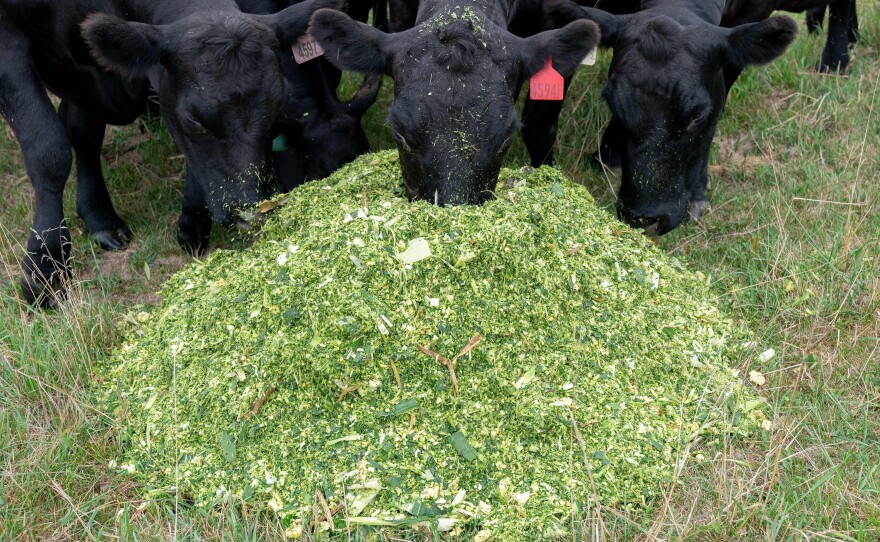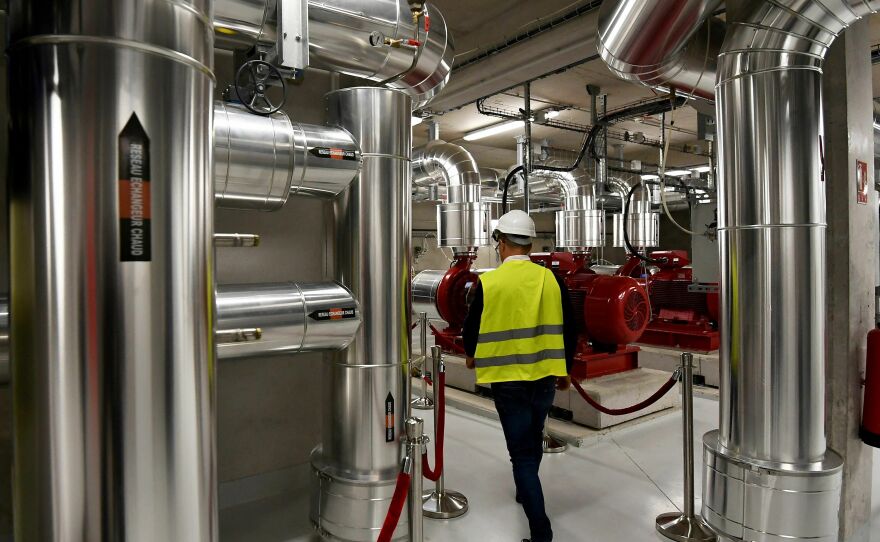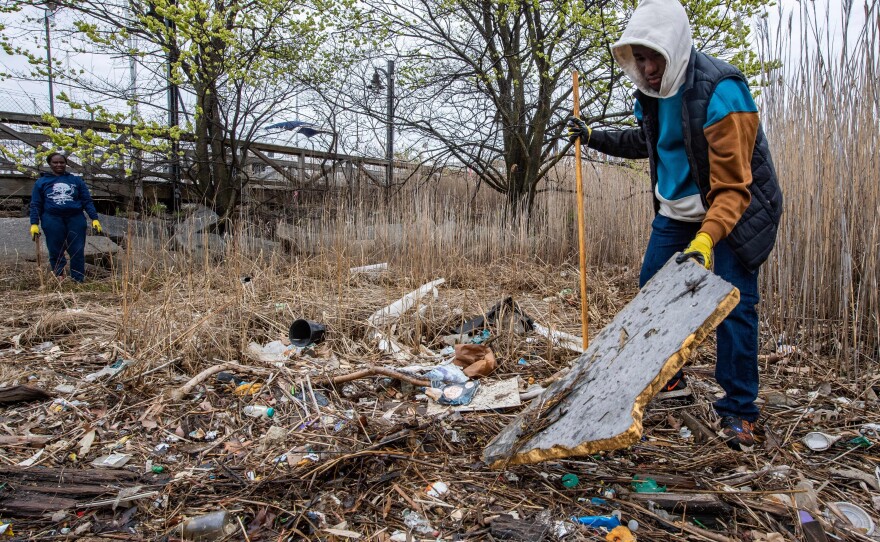Climate change can often feel like an overwhelming and insurmountable challenge, but many communities across the nation are already working to adapt and become more resilient: Some are getting creative with water conservation, finding new sources of energy to power their communities, and even recycling poop.
Climate change is here. And this week, NPR is doing something new. We're dedicating an entire week to focus on the search for climate solutions, with stories across our network.
Here are just a few of the ways communities across the country are adapting to be more resilient to the demands of a changing climate.
Recycling waste
Inspired by the purification process water goes through in nature, engineers are recycling raw sewage into potable water that's safe to drink. As KUNC's Alex Hager explains, in the Western U.S., there's more demand for water than there is supply, particularly in the Colorado River basin. [via KUNC]
For every gallon of reuse water that we can use outside, that frees up that gallon of culinary water for future growth of the area.
Earlier this year, in an effort to adapt to a hotter and drier future, Boise, Idaho, tested five different technologies to scrub industrial wastewater of chemicals and pollutants so it can be reused. [via Boise State Public Radio]
In St. George, Utah, the city's water reclamation plant is preparing to use treated and reclaimed water for irrigation and save more of the city's current water supplies for drinking or culinary use. [via KUER]

Strategies to minimize greenhouse gas emissions
Efforts in Maine aim to turn low-quality byproducts of the lumber industry into wood-fiber insulation, locking carbon in the walls of new construction. [via Maine Public]
Methane is also a significant driver of global climate change, and in the U.S., cows are the second largest source of it — more specifically, they burp it as they're digesting fiber. But scientists at the University of New Hampshire have found that adding certain types of seaweed to the cows' diet seems to help them belch less methane. [via WBUR]
Doctors at Seattle Children's Hospital say they've managed to tame one of the hospital's biggest environmental impacts: The gases used to sedate patients.
A puff of nitrous oxide traps 310 times more heat in the atmosphere than the same amount of carbon dioxide, the main pollutant responsible for overheating the world. The anesthetic desflurane traps 2,540 times more heat than carbon dioxide.
Anesthesiologists at Seattle Children's report cutting the impact of their anesthetic gases on the climate by 87% in the past five years. [via KUOW]
Seattle Children's Dr. Elizabeth Hansen is launching a national network of children's hospitals that will show clinicians the climate impact of their work as a tool to curb greenhouse gas emissions. Similar efforts at Massachusetts General Hospital are a key step in Mass General's pledge to reach net zero emissions by 2050. As WBUR's Martha Bebinger explains:
Nurse anesthetists and anesthesiologists were already getting monthly performance reports that showed how well they avoided low blood pressures during surgery and postoperative nausea. Now, they also see two climate assessments: The global warming footprint of the gases they choose and whether they are reducing the flow, or amount of gas used. [via WBUR]

Renewable energy
The next breakthrough in renewable energy might be poop: New scientific techniques pioneered at Brigham Young University point to the potential of converting animal and human waste into energy that can be used to replace natural gas from fossil fuels. [via KUER]
In Washington state, what started as a joint effort between farmers and the Tulalip Tribes to keep manure runoff from nearby waterways is now not only capturing methane and producing valuable renewable energy, but may soon be producing hydrogen from cow poop. [via KNKX]
As more efforts to confront climate change include the use of hydrogen, Colorado has adopted the country's first standards for clean hydrogen. As Colorado Public Radio's Sam Brasch explains, without these guardrails, environmental groups worry that hydrogen technologies could draw power from gas and coal plants, resulting in a rise in climate-warming emissions, not a reduction. [via CPR]
Colorado's largest gas and power company is already planning to experiment with mixing hydrogen into its natural gas system as part of its climate strategy. [via CPR]
Hawaii has mandated a transition to 100% renewable energy by 2045, and it was the first state to set such a goal. According to Chief Energy Officer Scott Glenn, the island of "Kauaʻi is already 100% renewable during the day, [and] 70% renewable overall," while neighboring Oʻahu has more power available to the grid through rooftop solar than through any one power plant. [via Hawai'i Public Radio]
Loading...
A California program has used cap-and-trade money to pay for climate action at the neighborhood level, purchasing eclectic buses, planting hundreds of trees, building affordable all-electric housing and installing rooftop solar. LAist's Erin Stone explains who can qualify. [via LAist]
Meanwhile, New England's largest energy utility is building a "networked geothermal system" that uses water-filled pipes to heat and cool 37 buildings. As WBUR's Miriam Wasser explains, "because the New England electric grid is mostly powered by fossil fuels, there is still some carbon pollution associated with it. Over time, though, as the region shifts to more renewable electricity sources, those emission savings will be even larger." [via WBUR]
New Hampshire is one of the latest states to experiment with different ways to increase renewable energy use at the local level by turning to community power programs. These programs control at a local level where they buy power for their community and can choose more renewable sources as a result. [via NHPR]
Engineering solutions
Last year, one of the hottest neighborhoods in Los Angeles painted 10 square blocks with "cool paint" designed to reflect solar radiation, instead of absorbing it. As LAist's Erin Stone found out, the special acrylic-based coating does a better job preventing the area just above the surface from getting hot, compared with the asphalt-based coatings the city has traditionally used. [via LAist]
In Massachusetts, which has lost roughly 41% of its salt marshes since 1777, restoration ecologists are using ribbed mussels to help restore the valuable coastal wetlands that protect homes and roads from storm surge, filter water and serve as habitat for birds and baby lobsters. The little mussels — or "habitat engineers" — could be key to stabilizing unhealthy salt marshes that are further threatened by sea level rise. [via WBUR]
Last fall, the Swinomish Tribe built the first modern clam garden in the U.S., a type of environmental engineering that captures sediment and expands the habitat for butter and littleneck clams. As KUOW's John Ryan explains, while the ecological benefits might take years to materialize, the human benefits have already begun. [via KUOW]
NPR's Emily Alfin Johnson produced this piece and NPR's Amy Morgan edited this piece, which includes reporting from member station newsrooms across the country.
Copyright 2023 NPR. To see more, visit https://www.npr.org. 9(MDAzMjM2NDYzMDEyMzc1Njk5NjAxNzY3OQ001))







